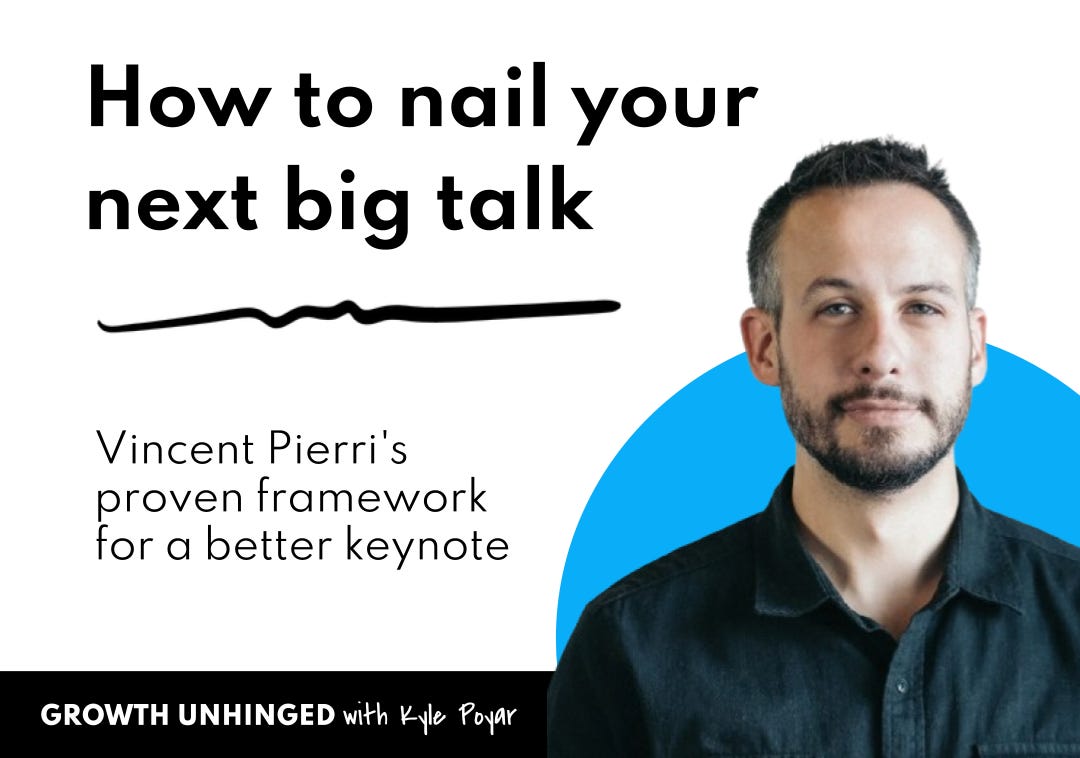How to nail your next big talk
Vincent Pierri's proven framework for a better keynote
👋 Hi, it’s Kyle Poyar and welcome to Growth Unhinged, my weekly newsletter exploring the hidden playbooks behind the fastest-growing startups.
I used to be terrified of public speaking. And the more I thought about it, the worse my nerves would get: my palms would sweat, my voice would crack, and I couldn’t stay present enough to connect with the audience. But I pushed through the nerves (with an assist from Big Pharma) and am absolutely glad I did.
If you’re even a little like me, you’ll want to bookmark today’s post from Vince Pierri. Vince is a Midwestern pastor-turned-public speaking guru who’s personally delivered 300+ unique talks in the last five years. He joins Growth Unhinged to share his proven framework for a better keynote — just in time for peak conference season.
Most execs dread public speaking.
Not because they’re bad leaders. But because standing on stage with 500 eyes staring back at you is a completely different game.
I’ve coached SaaS CEOs, Fortune 500 VPs, and startup founders raising their Series B. And here’s what I’ve learned: the #1 obstacle isn’t stage fright.
It’s structure.
When leaders don’t know where their talk is going, their nerves spike. And when they ramble through a messy outline, their credibility takes a hit.
The solution? A repeatable framework. One that takes you from a blank page to a confident, well-paced talk. Here’s the one I use with every client.
Step 1: Nail the intro (5 minutes)
Every great talk begins with tension.
Think of your intro as the “hook.” It’s where you earn the right to keep people’s attention. If you lose the first five minutes, you’ll spend the next twenty-five trying to win them back.
Here’s the three move formula:
Pain Point (2 min)
Start where your audience already is. What challenge or frustration do they feel? Keep it short and relatable.
Common mistake: most leaders jump straight into their solution. Don’t. If people don’t feel the pain, they won’t care about your cure.
Problem (2 min)
Go one level deeper. Reveal the underlying reason this pain keeps happening.
Example: “The real reason your churn is high isn’t your product. It’s your onboarding.”
Common mistake: vague statements like “change is hard” or “the market is competitive.” Get specific. Executives respect precision.
Promise (1 min)
End the intro with a clear payoff. Tell them exactly what they’ll walk away with.
Example: “Today I’ll show you the three onboarding shifts that cut churn by 40% in six months.”
That’s your contract with the audience. Keep it simple. Keep it specific.
Step 2: Build trust (3 minutes)
Your title might get you the microphone. But it won’t earn you trust.
Trust-building is where you prove you’ve walked the path. Three ways to do it:
Experience. A quick story of failure, experiment, or success.
Research. Credible data, case studies, or benchmarks.
Relatability. A short personal story that shows you’ve been in their shoes.
Pro tip: vulnerability is powerful here. Most execs think they need to project authority by hiding mistakes. Wrong. Admitting a real struggle makes people lean in.
Example: “When I first became a VP, I thought my job was to have all the answers. Turns out, my team didn’t need answers — they needed clarity.”
Step 3: Deliver three main points (3 × 6 minutes)
Keep reading with a 7-day free trial
Subscribe to Kyle Poyar’s Growth Unhinged to keep reading this post and get 7 days of free access to the full post archives.







